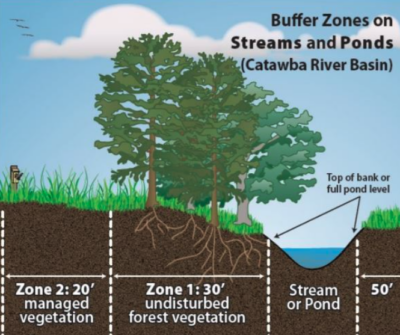There are A LOT of regulations around the shoreline and buffer zones on a waterfront Lake Norman home.
Don’t be discouraged. Most homes already have amazing yards with everything you’d need.
Land affects Water…
What you do with in the land impacts the drinking water and ecosystem health not only of Lake Norman but all areas downstream.
Imagine you buy a peaceful wooded lakefront home and all your neighbors decide to bulldoze the trees along the water and pour concrete to park their RVs and cars.
How would that make the lake look? How would it impact your property value? Imagine the runoff into the water during storms, polluting the water around your dock.
Rules, though restrictive, are meant to protect and preserve the value of your waterfront Lake Norman home.
Important!
Each town may have exceptions and variances to some items discussed below. This article gives you the foundation when looking at waterfront Lake Norman homes. You may be able to build a pool or do a home addition that violates laws discussed here with local approvals…
It’s a VERY complicated process. For example, Cornelius has over 200 pages of guidelines that impact “grandfathered” smaller home lots for older neighborhoods.
You should hire a professional during inspections, to help navigate what’s possible for your dream waterfront Lake Norman home from a code enforcement perspective.
The Authorities
State
They created the foundation for all the water areas of North Carolina.
Duke Energy
May restrict or modify the state laws depending on Lake Normans needs.
County & Towns
Can provide variances or restrictions based on each waterfront lots unique characteristics
Your Yard
Setbacks. Buffer Zones. Watersheds. Riparian Buffers.
Let’s just call it a Buffer…
The main overarching laws are found in the Catawba River Basin Riparian Buffer Protection Program (say that 3 times fast) created by the North Carolina Department of Environmental Quality (DEQ).
What is a Buffer?
A strip of vegetated land bordering the lake (your yard). The vegetation and root systems stabilize the bank, remove pollutants, and prevent soil from eroding into the water.
50 foot
A waterfront Lake Norman property has a 50-foot total setback buffer inward from the shoreline. It is broken up into 2 Zones, which allow for different uses.
Zone 1
The first 30 feet from the shoreline inward is an undisturbed forested buffer.
Zone 2
The next 20 feet from Zone 1 inward is managed vegetation.
But wait…
You’ve been looking at waterfront Lake Norman homes and the backyard isn’t a forest. They have a lawn to the waters edge, barely any trees and a boat house on the shore.
Many lots were developed before the rules were put in place, so they’re grandfathered in. And remember from before, some towns may have allowed for variances if the owner mitigated the impact in other ways (will discuss later).
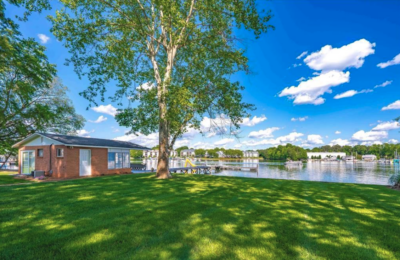
What is allowed in the Buffers
The buffer must remain undisturbed, unless the activity is listed in the Table of Uses as; “deemed allowable”, “allowable upon authorization”, or“allowable with mitigation upon authorization”.
Clear as mud right?
Scenario 1
You want to build a playground for your kids near the waterfront. You have the perfect spot, but you need to cut down a few trees in Zone 1 to install it.
Can you? Maybe. This is deemed “Allowable with authorization”. You’ll need permission to do it first.
Scenario 2
You want to build a new deck on the back your Lake Norman home in buffer Zone 1, but you don’t need to remove any trees. Great, but you’ll still need authorization.
Need to remove a few trees to build that same deck? You’ll need authorization and a mitigation plan (usually planting more new trees that can become equal size to what you removed).
Scenario 3
You want to remove some tree branches to clear up your lake view.
You can remove them from the lower half of the tree, as long as they’re not more than 3 inches thick.
If you want to remove anything in the upper half you’ll need authorization first.
See how important this is?
It will impact your ability to build pools, decks, firepit areas, seating areas, etc…
More tree talk…
Want to remove waterfront trees completely? With authorization you can:
- Zone 1 (0’ – 10’) Only remove “High Value” trees > 18” diameter, if their roots aren’t exposed.
- Zone 1 (10’ – 30’) Cut no more than 50% of trees > 5” diameter. Remaining trees should be evenly spaced apart.
- Zone 2 (30’ – 50’) All tree removal is allowed, but must maintain ground cover.
Other landscaping activities in the 50-foot buffer zone:
Allowed:
- Trees may be treated to maintain or improve their health, form, or vigor.
- Removal of trees that are in danger of causing damage to structure or human life.
- Planting of trees, shrubs or ground cover.
Allowed with Restrictions:
- Removal of dead or infected trees or use of pesticides to prevent tree pest and disease.
- A one-time fertilizer application to establish replanted vegetation. (No runoff from the fertilizer application is allowed into surface water.)
Mitigation & Variances
Let’s say you found the perfect waterfront Lake Norman home but needed to add an addition to the back to meet your needs, or install a pool that would violate the buffer zone. Are you out of luck? It depends.
You can apply for a major / minor variance with Variance Application (VAR-10-2013) to seek approval for activities within protected buffers. Variances and mitigations can allow you to do things you wouldn’t normally be allowed to do. It’s a way of offsetting a project’s environmental impacts to a buffer. It can take a few basic forms:
- Restoration or enhancement of a non-forested riparian buffer (planting twice the amount of removed trees in another area of Zone 1 or 2).
- Payment of a mitigation fee to a wetlands and buffer restoration fund.
Just know you have options.
(note: If the violation was present within the buffer as of June 30, 2001, it is grandfathered in.)
Duke Energy Vegetation Requirements
If you find a waterfront Lake Norman home with a gentle slope into the water that is prone to being under water during the busy seasons when the lake is “Full Pond”, then the area and all the plants / trees in that zone are under Duke Energy’s control. This will add another layer outside of the above local government regulations you will have to deal with.
I won’t go over all the details, but they’re similar to those we discussed. Here are some examples:
Home 1

Notice this waterfront home has some flooding when the lake is at “Full Pond”. This means Duke Energy’s vegetation rules apply to the yard area that is underwater.
Home 2
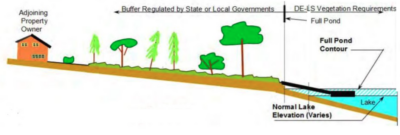
Notice this lakefront home has a steeper yard and no flooding in any forested areas when the lake is at “Full Pond”. This means Duke Energy’s vegetation rules don’t apply.
Some Rules:
- Trees – that fall into the lake and do not block or unnecessarily restrict navigational access should be left in place to benefit fish and/or wildlife.
- Footpaths – shall be no more than 4-ft wide and should be designed in a winding manner, avoiding trees.
- Viewshed Management – Standing live trees (> 3 inches diameter) that are intentionally removed for the creation of viewsheds or access paths shall be replaced by a quantity of trees totaling the diameter of the tree removed. Replacement trees should be a native “ecological equivalent” of what is removed (i.e., a tree removed from the canopy should be replaced with a similar species that also has the potential to reach the canopy).
Violations
What’s the worst that can happen by not following the rules? You can lose your waterfront Lake Norman homes dock…
Unauthorized major cutting of the vegetated area (no existing pier/dock)
- Restoration with approved native vegetation.
- Loss of consideration for lake use permitting activities for up to five years depending on severity and subject to successful plant restoration
Unauthorized major cutting of the vegetated area (existing pier/dock):
- Removal of the pier/dock and restoration with approved native vegetation.
- Loss of consideration for lake use permitting activities for up to five years depending on severity and subject to successful plant restoration.
Unauthorized minor cutting of trees within the vegetated area:
- Restoration as required in the Vegetation Management Requirements for approved tree removal.
Shoreline
When you’re seeing waterfront homes for sale on Lake Norman, you’ll notice a few different types of shoreline and how its “stabilized”.
Based on what’s there, you may want to change it by adding a beach, or building access stairs to the water level. Everything involving the shoreline and its stabilization must obtain written authorization from Duke Energy.
Shoreline stabilization is encouraged to control soil erosion in “high-energy” areas. You are encouraged to use bioengineering techniques and landscape plantings before using rip-rap. Seawalls should be the last option for shoreline stabilization.
Bio-engineering
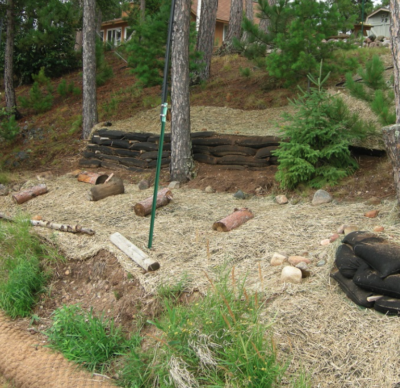
This is basically plants and some landscaping rocks. If the waterfront homes lot is a gentle slope into the water and erosion isn’t present, this will be your only approved option.
The types of plantings used in bioengineering and landscape-planting projects should be native to North Carolina.
Rip-rap
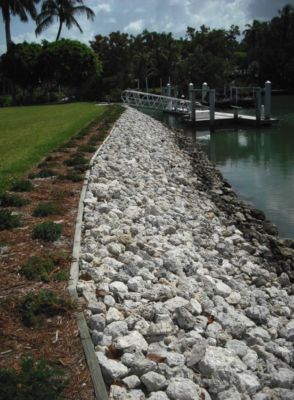
Riprap is a human-placed rock or other material used to protect shoreline against water erosion. It lets the waves bounce off the rock instead of your soil.
A layer of rip-rap extending six feet lakeward from full pond must be placed along the entire area.
Seawalls
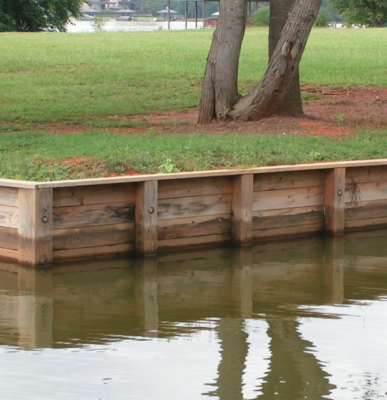
Seawalls are not allowed in areas with an eroded bank height of less than 3 feet.
This is used for waterfront Lake Norman homes that have no other option.
Remember
These are just the basics, every town will have extensive rules and allowances.
For example, Cornelius waterfront Lake Norman homes are subject to additional Floodplain Regulations, Post-Construction, Surface Water Improvement & Management SWIM, Stormwater Management and Pollution Control, Water Supply Watersheds, and more…
If you think you’ll want to change something major that might fall within these areas, consult a professional. You might have to weigh the time of doing that with writing an offer fast, if the home is at risk of being sold to someone else….


